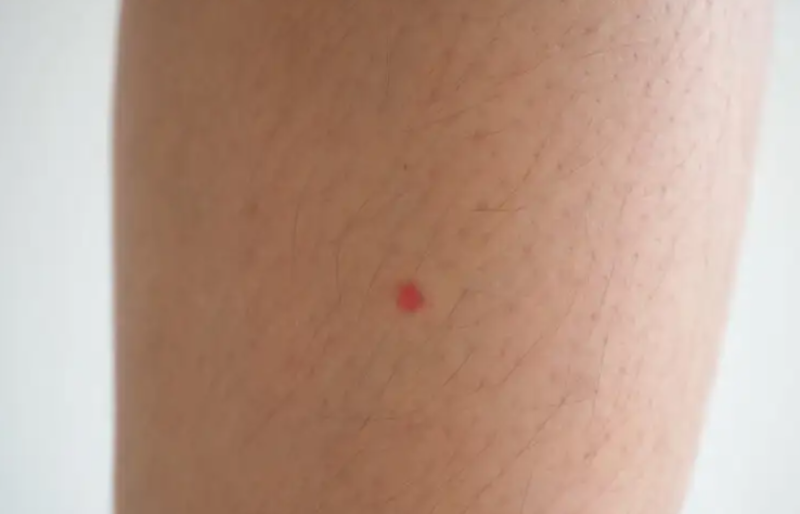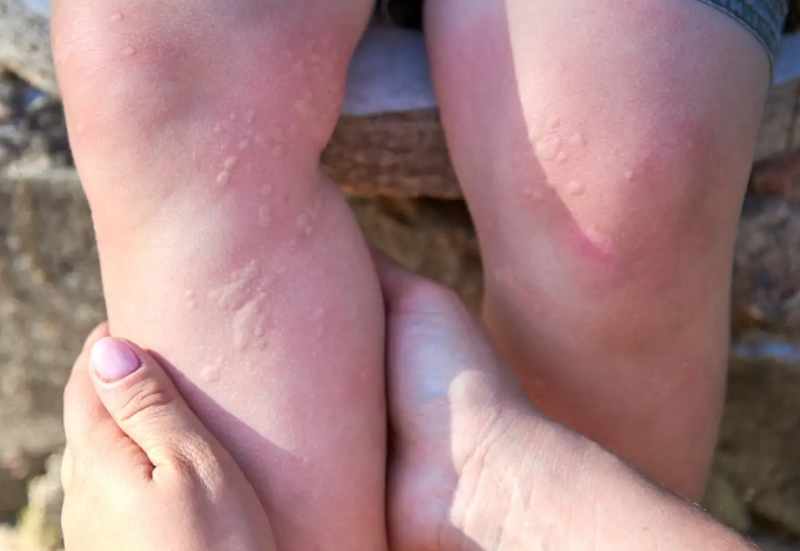
The red spots on the legs can appear occasionally or recurrently. Sometimes, they remit after a short time; but other times, they become permanent.
Regarding this, there are various causes of red spots on the legs. This includes allergic reactions to medications, insect bites, circulation problems, psoriasis, and dermatitis.
However, if other symptoms do not accompany them, there is usually no cause for concern. But if there is a fever, pain in the area, intense itching, or burning, it could indicate disease.
Contents
Causes of red spots on the legs
In various areas of the body, there may be reddening of the skin, from the face and neck to the feet. Each one has different characteristics and a reason or factor that triggers them.
Petechiae are certain round, reddish spots on various body parts, including the legs. They may respond to a bleeding disorder or infection.
We will not differentiate between Petechiae and the other presentations for practical purposes. Next, we will know the possible causes of red spots on the legs.
Rash
The rash is caused by heat, which causes the sweat glands to become blocked. Usually, it manifests in large areas of the skin, such as the legs or the back; or where there are folds, such as the groin, armpits, and neck. In addition to the red spots, there is also itching and minor rashes on the affected area.
Atopic dermatitis
Atopic dermatitis, also known as eczema or atopic eczema, is another reason red spots can appear on the legs. This skin disease, in addition to redness, causes itching and scaling.
It manifests at any age, although it is more common in children. The causes are unknown exactly.
According to studies, it is considered a multifactorial process related to genetic and immune aspects. It can stay a lifetime.
keratosis pilaris
This is a relatively common yet harmless condition. It is due to an excess in the production of keratin, a fundamental protein for the epidermis, as well as for nails and hair.
In particular, keratosis pilaris manifests with lesions that look like small bumps or pimples and red spots on the legs, buttocks, and cheeks. It is common in people who tend to dry skin or have allergic pathologies.
mycoses
There may also be red spots on the legs due to mycosis. This term is used to refer to skin conditions caused by fungi. Symptoms of fungal infections include the following:
- Blisters.
- Flaking.
- Itch.
- Discoloration or redness.
Among the mycoses, mention should be made of ringworm, also called tinea corporis. Ringworm spots look like round patches, circular and lighter in the center.
Psoriasis
This is a chronic autoimmune disease. In psoriasis, the body produces excessive skin cells.
Its most notorious symptoms are itching, scaling, and red spots on the legs, soles of the feet, hands, or scalp.
Scabies
This disease is caused by Sarcoptes scabies, a mite that infects the skin and can be transmitted by direct contact. In scabies or scabies, redness, itching, burning, hyperkeratotic lesions (thickening of the skin), and even ulcers occur when the person scratches.
Cellulitis
Although it has a similar name, it should not be confused with cellulite, which affects it from an aesthetic point of view. Unlike this, cellulite infection is a severe problem. Colonization with streptococci or staphylococci produces it.
Circulation problems
When there are circulation problems, some symptoms appear in the extremities, such as the following:
- Red spots on the legs.
- Tingling or itching sensation in the feet.
- Cold or dry feet.
Chronic diseases
Red spots on the legs can also be a clinical sign of care since they are associated with some chronic diseases, such as skin cancer or lupus.
Allergic reactions
Finally, allergic reactions due to insect bites, consumption of some medications, or contact with substances (allergens) can also cause red spots on the legs.
What to do if there are red spots on the legs?
Sometimes, the red spots on the legs can go away independently. For example, when they are due to rashes. Other times treatment will be required, or some preventive measure must be taken.
Suspension of treatments
When it is suspected that the red spots on the legs are due to a reaction to a medication, it is necessary to contact the doctor and inform him of such a reaction. In this case, suspension or substitution by another drug with a similar effect can be considered.
Antifungals
In ringworm and other mycoses, the treatment to follow includes the use of oral or topical antifungal or antifungals. This, of course, should only be done if prescribed by the professional.
antibiotics
Some petechiae that are of infectious origin require antibiotics; the same for cellulite. In addition, antibiotics may be recommended in people with eczema to prevent potential superinfections.

antihistamines
When the red spots on the legs are due to an allergic reaction, the first thing to do is identify the cause (allergen) to avoid contact. An antihistamine may then be given to relieve symptoms.
Non-steroidal anti-inflammatory drugs and corticosteroids
In cases where inflammation and skin redness are present, non-steroidal anti-inflammatory drugs and corticosteroids can be used. The latter is recommended in lupus, for example.
topical creams
Various ointments relieve itching or irritation, often accompanying the appearance of red spots on the legs. Topical hydrocortisone creams are typically used. Although there are also based on natural products; for example, those of aloe vera that have obtained successful results in the approach of psoriasis, as reported by studies.
Changes in diet and habits
Also, in cases of problems with circulation, it is recommended to make changes in the diet, reducing the amount of salt and increasing the consumption of vitamin C. Likewise, moderate and regular physical activity should be carried out.
Should you see a doctor if there are red spots on the legs?
Red spots on the legs do not necessarily constitute a warning sign. They can be due to various causes, from allergic reactions and infections to contact with substances or insect bites.
Now, you have to pay attention if other symptoms appear in addition to redness. Itching or intense burning, pain in the area, or fever are of greater awareness among these.
It is important to note that, sometimes, the red spots on the legs could indicate some underlying chronic disease. Therefore, going to the doctor will make it possible to make a timely diagnosis.